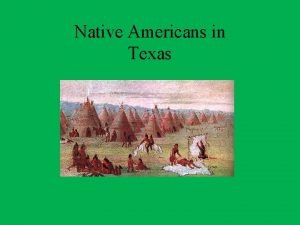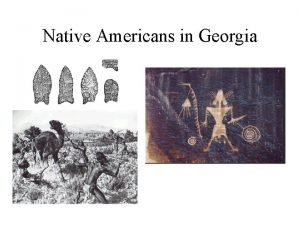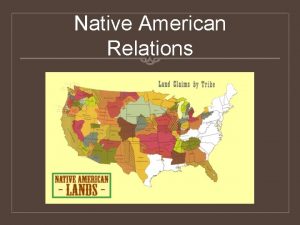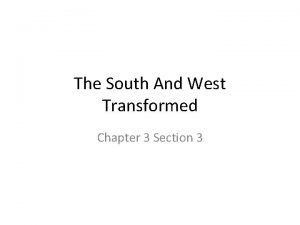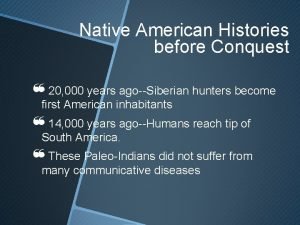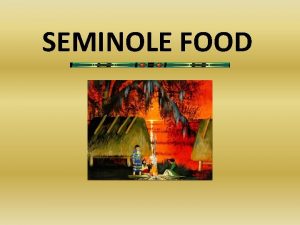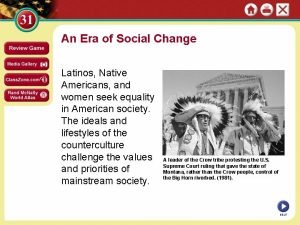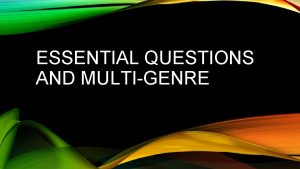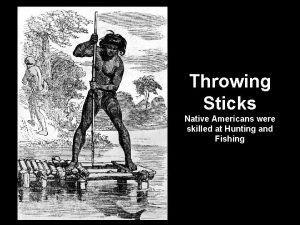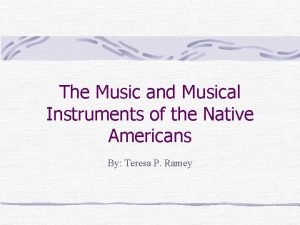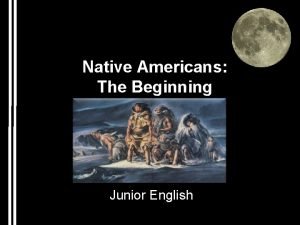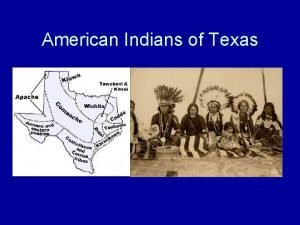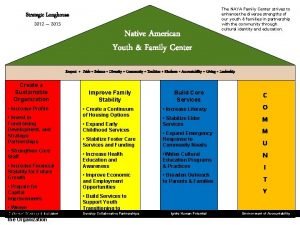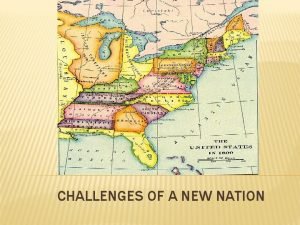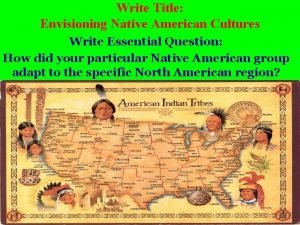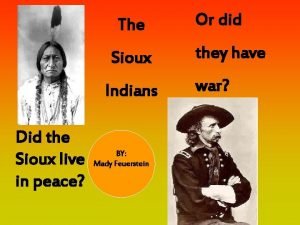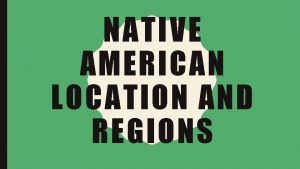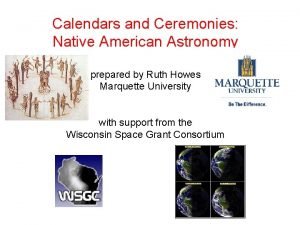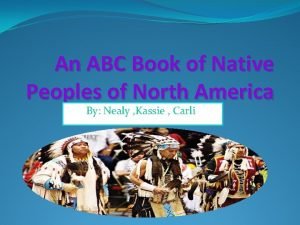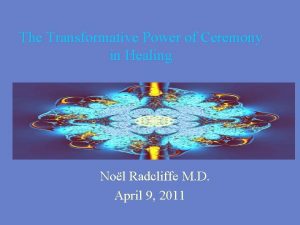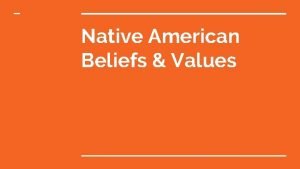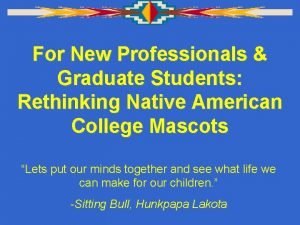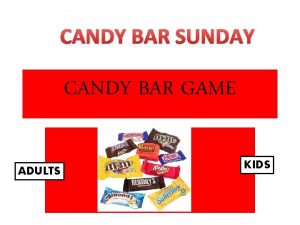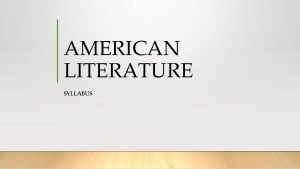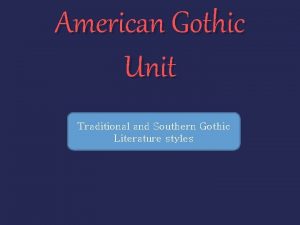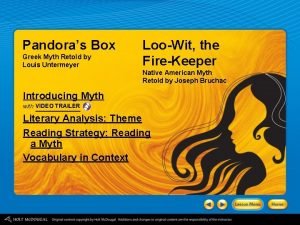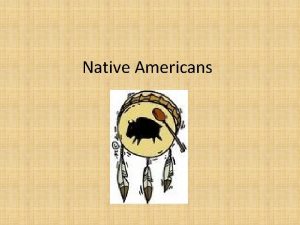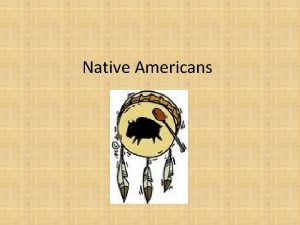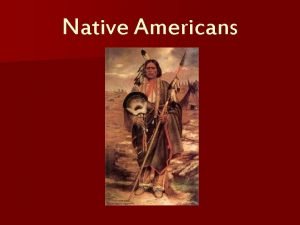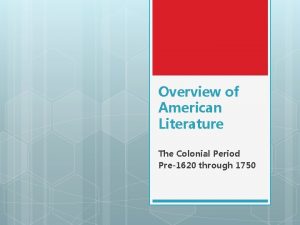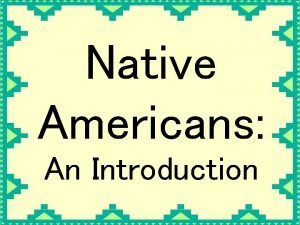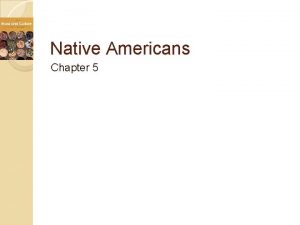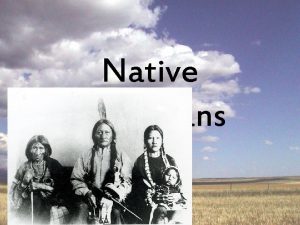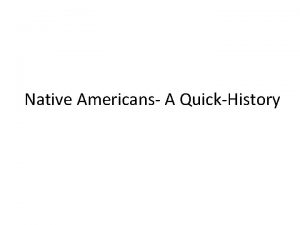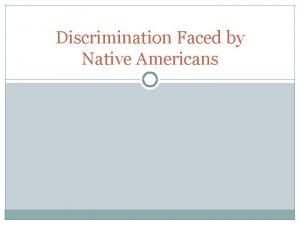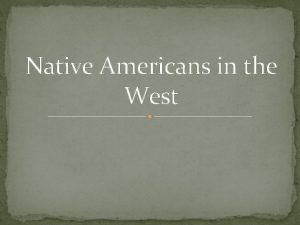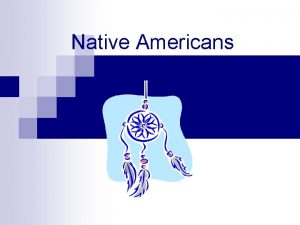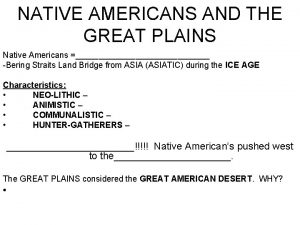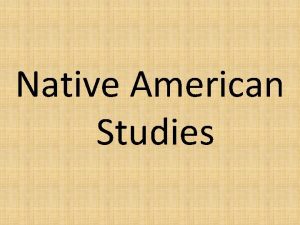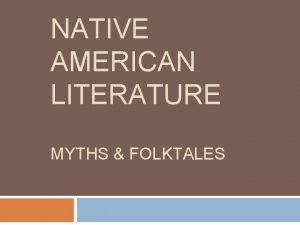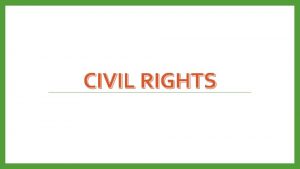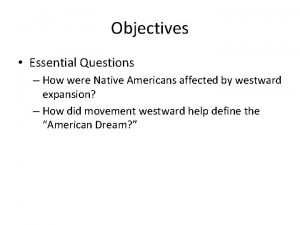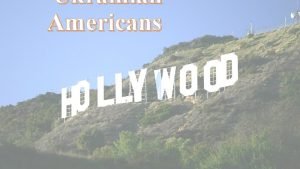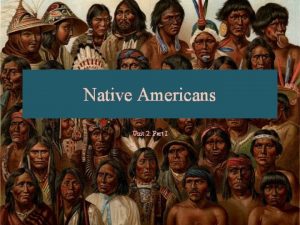Native American Unit Pre1620 Native Americans Essential Questions


































- Slides: 34

Native American Unit Pre-1620

Native Americans Essential Questions What images or ideas come to mind when you think of Native Americans? What exists in our world or everyday lives today that has Native American Influences?

Historical Context Historical context- the social conditions that influence the creation of a work

Characteristics of Literature Supernatural forces--Spiritual imagery Appreciation of nature and creation Conflict Teaches a lesson Repetition Performance; oral tradition

Types of Literature Oral stories Myths Sacred songs Trickster tales Prayers poems

Time Line � 2000 -1000 B. C. – (3000 -4000 years ago) Maize began to be cultivated in the southwest leading to an agricultural economy � A. D. 500—Native Americans often used currency called “waupumpeag” along with bartering for goods � 800 - Mound Builder culture developed along the Mississippi River � 1000 - The Anasazi in the southwest built and lived in villages � 1492 - Christopher Columbus lands in the Bahamas � 1607 - First permanent English Colony set up in Jamestown � 1619 - First Africans arrive in the New World as indentured servants

Native Ameican Unit Pre-1620 Here we present an image of Lucille, a Young Native American Girl. It was taken in 1907 by Edward S. Curtis.

Maize (corn) Maize was a staple of the Native American diet. A Hopi Bride had to spend four days grinding corn for her betrothed's family in order to prove her worth.

Wampumpeag Iroquois wampum belt: New York or Eastern Canada

Mound Builder culture (c. 800) Etowah Indian Mound at the Ocmulgee State Park in Macon, Georgia

Anasazi cliff dwellings (c. 1000) The Anasazi built elaborate dwellings in the sides of cliffs. This may have been for defensive purposes. The community dwellings were abandoned in the late 1300’s.

Christopher Columbus landed in the Bahamas in 1492 Christopher Columbus thought he was in India so he named the Native Americans “Indians”

Jamestown, Virginia 1607 Jamestown was the first permanent English settlement in North America. The Powhatan Indian taught the colonists how to plant corn and tobacco, saving the colonists from starvation

Indentured Servents (c. 1679) In 1619, 20 Africans Twenty African people brought to Jamestown, Virginia on a Dutch ship and sold as indentured servants. were brought to Jamestown on a Dutch ship as Indentured Servants. This was the start of slavery that lasted nearly 200 years.

In Harmony with Nature Native American Traditions

The People � The Native Americans did not think of themselves as living in a single nation- rather they thought of themselves as distinct groups. � Original native peoples belonged to over 200 groups that spoke more than 500 languages. � They called themselves names such as “Anishinabe”, “Dine”, and “Lakota”- each meaning “The People. ” � Their ways of life were dictated by their natural surroundings and varied greatly. � They had complex religious beliefs, sophisticated political systems, and strong social values. �

Definitions Please copy down the definition

Literary Terms to Know Myth Cause and effect Repetition Incremental Repetition Imagery Folk tales Setting Internal conflict External conflict Inference Symbol Trickster tale

Folktale A folk tale is a short, simple story that is handed down, usually by word of mouth, from generation to generation. Folk tales include legends, fairy tales, myths, and fables. Folk tales often teach family obligations or societal values. “Coyote and the Buffalo” is an Okanogan folk tale and the “the Indian and the Hundred Cows” is a Hispanic folk tale. Some other popular examples: Robin Hood, Cinderella, Arabian Nights (Aladdin)

Myth � Myth-a traditional story, passed down through generations, that explains why the world is the way it is. � A myth is a form of the folktale � Myths are essentially religious, because they present supernatural events and beings and articulate the values and beliefs of a cultural group. � Some popular myths are also found in other cultures: Greek myths about the gods (Zeus), Egyptian myths (Sun god Ra), Chinese Myths about animals and the use of an animal (the tiger).

4 Essential Functions of a Myth 1. To instill a sense of awe toward the mystery of the universe. (Wow! that’s how the stars got there) 2. To explain the workings of the natural world. (that’s why the ocean has tides, there are stars in the night sky and the rain falls from the sky) 3. To support and validate social customs. (that’s why there is a warrior ritual) 4. To guide people through the trials of life. (that is why we act the way we do or we should act in a certain way)

Trickster Tale A trickster tale is a folk tale about an animal or person who engages in trickery, violence, and magic. Neither all good nor all bad, a trickster may be foolish yet clever, greedy yet helpful, immoral yet moral. “Coyote and the Buffalo” and the “Fox and the Coyote and Whale” are both trickster tales.

Cause and Effect When events have a cause-andeffect relationship, one (the cause) directly brings about the other (the effect). In the Iroquois myth, the actions of supernatural beings cause the present features of the world to exist. For example: (cause) the engines died on the airplane (effect) the plane crashes.

Repetition is the recurrence of words, phrases, or lines For example the first line of “Song of the Sky Loom” is the same as the last line. Think of the music lyrics you might listen to how words or phrases are repeated throughout a song or Dr. Seuss books as in the instance of Green Eggs and Ham: it keeps repeating “Sam I Am”

Incremental Repetition The structure of a line or stanza is repeated a certain number of times, with a slight variation in wording each time. “Song of the Sky Loom” May the warp be the white light of morning, May the weft be the red light of evening, May the fringes be the falling rain, May the border be the standing rainbow

Imagery The descriptive words and phrases that a writer uses to re-create sensory experiences are called imagery. Keep in mind anything you can imagine (while reading the words in a text) that appeals to your sight, smell, sound, taste or touch is a direct a part of the imagery the author is trying to convey to you the reader.

Setting The setting of a literary work refers to the time and place in which the action occurs. A story can be set in an imaginary place, such as an enchanted castle, or a real place such as New York City or Plymouth, Massachusetts. The time can be the past, the present, or the future.

Conflict A conflict is a struggle between opposing forces that is the basis of a story’s plot. Man vs. Society Man vs. Self

External Conflict This conflict puts a character against nature, society, or another character. Man vs. Nature The Pilgrims arrived in the new world in the middle of winter without food or shelter. Man vs. Man The Pilgrims and the Indians were afraid of each other and fought against each other Man vs. Society The Pilgrims left England separated from the church of England so they could worship the way they wanted to.

Internal Conflict A conflict between opposing forces within a character. Man vs. Self For example: Metacomet ‘s mind was troubled because he wanted to keep his native ways and when other members of his tribe moved into the settlements and started wearing the clothes of the settlers he would not.

Inference A logical guess based on evidence. For example the character in this picture could be described as a great warrior, and a magnificent leader. You can infer that he was admired by his tribe.

What can we infer from this picture?

Symbol A symbol is a person, place, or object that has a concrete meaning in itself and also stands for something beyond itself, such as an idea or feeling.

What does this symbol mean?
 Where did native americans come from
Where did native americans come from Where did native americans come from
Where did native americans come from How many native americans died on the trail of tears
How many native americans died on the trail of tears What three circumstances hurt native americans
What three circumstances hurt native americans Portuguese sailor
Portuguese sailor Seminole indian food
Seminole indian food Latinos and native americans seek equality
Latinos and native americans seek equality Poetry essential questions
Poetry essential questions Plamatic acid
Plamatic acid Hopi rabbit stick
Hopi rabbit stick Native american musical instruments
Native american musical instruments How long have native american been living in america
How long have native american been living in america Native american religious beliefs
Native american religious beliefs Native american literature characteristics
Native american literature characteristics Medicine wheel theory
Medicine wheel theory Native american literature before 1600
Native american literature before 1600 Native american dwellings
Native american dwellings Red planet candy bar
Red planet candy bar Native american youth and family center
Native american youth and family center Native american connections housing
Native american connections housing Native american important facts
Native american important facts Native american tribes
Native american tribes Sioux writing
Sioux writing Native american skyscraper workers
Native american skyscraper workers Native american tribes in the united states
Native american tribes in the united states Native american cultural areas
Native american cultural areas Native american calendars
Native american calendars Native american abc book
Native american abc book Native american letting go ceremony
Native american letting go ceremony Native american morals and values
Native american morals and values Crayola crayons
Crayola crayons Superman's other identity candy bar
Superman's other identity candy bar Southern literature syllabus
Southern literature syllabus American gothic writers
American gothic writers Loo-wit, the fire-keeper is a native american myth.
Loo-wit, the fire-keeper is a native american myth.
